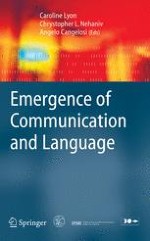2007 | OriginalPaper | Chapter
12. Language Change among ‘Memoryless Learners’ Simulated in Language Dynamics Equations
Authors : Makoto Nakamura, Takashi Hashimoto, Satoshi Tojo
Published in: Emergence of Communication and Language
Publisher: Springer London
Activate our intelligent search to find suitable subject content or patents.
Select sections of text to find matching patents with Artificial Intelligence. powered by
Select sections of text to find additional relevant content using AI-assisted search. powered by
